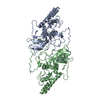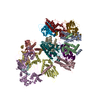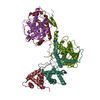[English] 日本語
 Yorodumi
Yorodumi- PDB-8i8c: Plug structure of the Autographa californica multiple nucleopolyh... -
+ Open data
Open data
- Basic information
Basic information
| Entry | Database: PDB / ID: 8i8c | ||||||
|---|---|---|---|---|---|---|---|
| Title | Plug structure of the Autographa californica multiple nucleopolyhedrovirus (AcMNPV) | ||||||
 Components Components |
| ||||||
 Keywords Keywords | VIRAL PROTEIN / virus / capsid protein | ||||||
| Function / homology | Baculovirus occlusion-derived virus envelope EC27 / Baculovirus occlusion-derived virus envelope protein EC27 / Autographa californica nuclear polyhedrosis virus (AcMNPV), C42 / Autographa californica nuclear polyhedrosis virus (AcMNPV), Orf101 / viral envelope / P40 / Occlusion-derived virus envelope/capsid protein Function and homology information Function and homology information | ||||||
| Biological species |  Autographa californica multiple nucleopolyhedrovirus Autographa californica multiple nucleopolyhedrovirus | ||||||
| Method | ELECTRON MICROSCOPY / single particle reconstruction / cryo EM / Resolution: 4.93 Å | ||||||
 Authors Authors | Jia, X. / Gao, Y. / Zhang, Q. | ||||||
| Funding support |  China, 1items China, 1items
| ||||||
 Citation Citation |  Journal: Nat Commun / Year: 2023 Journal: Nat Commun / Year: 2023Title: Architecture of the baculovirus nucleocapsid revealed by cryo-EM. Authors: Xudong Jia / Yuanzhu Gao / Yuxuan Huang / Linjun Sun / Siduo Li / Hongmei Li / Xueqing Zhang / Yinyin Li / Jian He / Wenbi Wu / Harikanth Venkannagari / Kai Yang / Matthew L Baker / Qinfen Zhang /   Abstract: Baculovirus Autographa californica multiple nucleopolyhedrovirus (AcMNPV) has been widely used as a bioinsecticide and a protein expression vector. Despite their importance, very little is known ...Baculovirus Autographa californica multiple nucleopolyhedrovirus (AcMNPV) has been widely used as a bioinsecticide and a protein expression vector. Despite their importance, very little is known about the structure of most baculovirus proteins. Here, we show a 3.2 Å resolution structure of helical cylindrical body of the AcMNPV nucleocapsid, composed of VP39, as well as 4.3 Å resolution structures of both the head and the base of the nucleocapsid composed of over 100 protein subunits. AcMNPV VP39 demonstrates some features of the HK97-like fold and utilizes disulfide-bonds and a set of interactions at its C-termini to mediate nucleocapsid assembly and stability. At both ends of the nucleocapsid, the VP39 cylinder is constricted by an outer shell ring composed of proteins AC104, AC142 and AC109. AC101(BV/ODV-C42) and AC144(ODV-EC27) form a C14 symmetric inner layer at both capsid head and base. In the base, these proteins interact with a 7-fold symmetric capsid plug, while a portal-like structure is seen in the central portion of head. Additionally, we propose an application of AlphaFold2 for model building in intermediate resolution density. | ||||||
| History |
|
- Structure visualization
Structure visualization
| Structure viewer | Molecule:  Molmil Molmil Jmol/JSmol Jmol/JSmol |
|---|
- Downloads & links
Downloads & links
- Download
Download
| PDBx/mmCIF format |  8i8c.cif.gz 8i8c.cif.gz | 167.3 KB | Display |  PDBx/mmCIF format PDBx/mmCIF format |
|---|---|---|---|---|
| PDB format |  pdb8i8c.ent.gz pdb8i8c.ent.gz | 126.4 KB | Display |  PDB format PDB format |
| PDBx/mmJSON format |  8i8c.json.gz 8i8c.json.gz | Tree view |  PDBx/mmJSON format PDBx/mmJSON format | |
| Others |  Other downloads Other downloads |
-Validation report
| Summary document |  8i8c_validation.pdf.gz 8i8c_validation.pdf.gz | 1.3 MB | Display |  wwPDB validaton report wwPDB validaton report |
|---|---|---|---|---|
| Full document |  8i8c_full_validation.pdf.gz 8i8c_full_validation.pdf.gz | 1.3 MB | Display | |
| Data in XML |  8i8c_validation.xml.gz 8i8c_validation.xml.gz | 52.2 KB | Display | |
| Data in CIF |  8i8c_validation.cif.gz 8i8c_validation.cif.gz | 74.3 KB | Display | |
| Arichive directory |  https://data.pdbj.org/pub/pdb/validation_reports/i8/8i8c https://data.pdbj.org/pub/pdb/validation_reports/i8/8i8c ftp://data.pdbj.org/pub/pdb/validation_reports/i8/8i8c ftp://data.pdbj.org/pub/pdb/validation_reports/i8/8i8c | HTTPS FTP |
-Related structure data
| Related structure data |  35247MC  8i8aC  8i8bC M: map data used to model this data C: citing same article ( |
|---|---|
| Similar structure data | Similarity search - Function & homology  F&H Search F&H Search |
- Links
Links
- Assembly
Assembly
| Deposited unit | 
|
|---|---|
| 1 |
|
- Components
Components
| #1: Protein | Mass: 41583.594 Da / Num. of mol.: 2 / Source method: isolated from a natural source Source: (natural)  Autographa californica multiple nucleopolyhedrovirus Autographa californica multiple nucleopolyhedrovirusReferences: UniProt: A0A0N7CQX9 #2: Protein | Mass: 33568.152 Da / Num. of mol.: 2 / Source method: isolated from a natural source Source: (natural)  Autographa californica multiple nucleopolyhedrovirus Autographa californica multiple nucleopolyhedrovirusReferences: UniProt: A0A0N7CT36 |
|---|
-Experimental details
-Experiment
| Experiment | Method: ELECTRON MICROSCOPY |
|---|---|
| EM experiment | Aggregation state: PARTICLE / 3D reconstruction method: single particle reconstruction |
- Sample preparation
Sample preparation
| Component | Name: Autographa californica multiple nucleopolyhedrovirus / Type: VIRUS / Entity ID: all / Source: MULTIPLE SOURCES |
|---|---|
| Source (natural) | Organism:  Autographa californica multiple nucleopolyhedrovirus Autographa californica multiple nucleopolyhedrovirus |
| Details of virus | Empty: NO / Enveloped: NO / Isolate: STRAIN / Type: VIRION |
| Buffer solution | pH: 7 |
| Specimen | Embedding applied: NO / Shadowing applied: NO / Staining applied: NO / Vitrification applied: YES |
| Vitrification | Cryogen name: ETHANE |
- Electron microscopy imaging
Electron microscopy imaging
| Experimental equipment |  Model: Titan Krios / Image courtesy: FEI Company |
|---|---|
| Microscopy | Model: FEI TITAN KRIOS |
| Electron gun | Electron source:  FIELD EMISSION GUN / Accelerating voltage: 300 kV / Illumination mode: FLOOD BEAM FIELD EMISSION GUN / Accelerating voltage: 300 kV / Illumination mode: FLOOD BEAM |
| Electron lens | Mode: BRIGHT FIELD / Nominal defocus max: 3000 nm / Nominal defocus min: 1500 nm |
| Image recording | Electron dose: 50 e/Å2 / Film or detector model: GATAN K2 SUMMIT (4k x 4k) |
- Processing
Processing
| CTF correction | Type: PHASE FLIPPING AND AMPLITUDE CORRECTION |
|---|---|
| Symmetry | Point symmetry: C1 (asymmetric) |
| 3D reconstruction | Resolution: 4.93 Å / Resolution method: FSC 0.143 CUT-OFF / Num. of particles: 36127 / Symmetry type: POINT |
 Movie
Movie Controller
Controller







 PDBj
PDBj